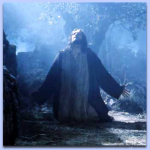Lent: Then and Now
“Even now,’ declares the LORD, return to me with all your heart, with fasting and weeping and mourning. Rend your hearts and not Your garments. Return to the LORD your God, for he is gracious and compassionate, slow to anger and abounding in love, and he relents from sending calamity.”
— Joel 2:12, 13
 The season of Lent begins this week on Wednesday. It is Ash Wednesday that begins the season of the Church Year called Lent. Historically, the season of Lent is one of the most important seasons of the church year. The season of Lent moves toward Holy Week: the time when we remember the crucifixion. Lent looks toward the Cross — and then beyond it to the miracle of Easter and the resurrection of Jesus.
The season of Lent begins this week on Wednesday. It is Ash Wednesday that begins the season of the Church Year called Lent. Historically, the season of Lent is one of the most important seasons of the church year. The season of Lent moves toward Holy Week: the time when we remember the crucifixion. Lent looks toward the Cross — and then beyond it to the miracle of Easter and the resurrection of Jesus.
Ash Wednesday arrives this week: Wednesday March 5.
The history of the season of Lent is interesting for us today. Though we do not celebrate it as people did in the past, a look at the history of Lent can give meaning to this season of the Church year.
Historically, Lent was a time of penitence. A mood of sadness and mourning prevailed. It was a time to remember the Cross and the terrible cost of our redemption. People felt it was inappropriate to celebrate at a time when the Savior was going toward the cross. So, at one time, weddings were forbidden during Lent. Public entertaining was outlawed during Lent. The sound of the organ was stopped. Members of the royalty would dress in black as if in mourning. It was a time to remember again that they had a part in sending Jesus to the Cross. It was a time to remember and confess their sins.
Historically, Lent was a time to prepare new converts for baptism. Lent represented six weeks of instruction, examination and prayer. It was a time to re-affirm the essential message of the faith, especially for those who had newly joined it.
Historically, Lent was a time of fasting. Once in the New Testament, the Pharisees asked Jesus why his disciples did not fast. Jesus replied, in essence, that it was because he was now with his disciples. But, he said a time was coming when he would leave them — and then, he said, they would fast. Since the time of Jesus’ ascension all Christian disciples have lived in that time of fasting.
Christians in earlier ages seem to have taken this more seriously than we do today. Fasting was a common ancient spiritual discipline. As far back as we can go — since the time of the apostles — Friday was a regular weekly fast day (remembering the crucifixion). During Lent, Good Friday and Holy Saturday were fast days. In the 300’s A.D. fasting was recommended for the entire period of Lent.
 Historically, Lent was a time of prayer. It was a time for the development of the spiritual life. During Lent Christians made for themselves what we might call “prayer reminders”. Out, of a dough of flour, salt and water they shaped the form of two arms crossed in prayer. These were baked and eaten during Lent. They are what we have come to call “pretzels”. Originally, they were prayer reminders eaten only during Lent. These pretzels were made at least as far back as the 400’s A.D..
Historically, Lent was a time of prayer. It was a time for the development of the spiritual life. During Lent Christians made for themselves what we might call “prayer reminders”. Out, of a dough of flour, salt and water they shaped the form of two arms crossed in prayer. These were baked and eaten during Lent. They are what we have come to call “pretzels”. Originally, they were prayer reminders eaten only during Lent. These pretzels were made at least as far back as the 400’s A.D..
In 1099 Pope Urban II declared the first day of Lent a special day of repentance for sin, giving it the name Ash Wednesday. In those times the priest would sprinkle ashes on the heads of worshipers telling them: “Remember that thou art dust, and to dust thou shalt return.”
This, then, is a little of the history of Lent. What is Lent to mean for us?
Lent is a time of learning and a time of remembrance. It is a time to return to the foundations of our faith. It is a time to remember anew the Cross of Jesus Christ, It is time to open our Bibles again to the stories of Jesus final days on earth, and to the New Testament witness to justification by faith.
 Lent is a time of prayer and self-denial: a time to strengthen and renew our spiritual life. We sometimes hear of people giving something up “for Lent”. This is a sort of watered-down version of the historic emphasis on fasting. Frankly, contemporary Christians feel uncomfortable with the ideas of fasting and self-denial. Our culture stresses consumption and the amassing of material possessions. “Enjoy yourself!” “Do whatever fulfills you.” We live in a self-centered culture. We hear justifications for behavior like: “you owe it to yourself.” Too often our Christianity is flabby, affluent, lazy, cold, merely intellectual; inconsequential. We say: “Surely fasting isn’t necessary?” But, the New Testament teaches that new life comes out of death. We find life in the losing of our lives. We follow Christ by taking up the Cross. We find all we need in seeking first God’s kingdom and righteousness. In that pursuit we find satisfaction, fulfillment and joy. Lent calls us away from the pursuit of our own pleasures, to the pursuit of God. It is a time to make prayer and spiritual discipline especially important.
Lent is a time of prayer and self-denial: a time to strengthen and renew our spiritual life. We sometimes hear of people giving something up “for Lent”. This is a sort of watered-down version of the historic emphasis on fasting. Frankly, contemporary Christians feel uncomfortable with the ideas of fasting and self-denial. Our culture stresses consumption and the amassing of material possessions. “Enjoy yourself!” “Do whatever fulfills you.” We live in a self-centered culture. We hear justifications for behavior like: “you owe it to yourself.” Too often our Christianity is flabby, affluent, lazy, cold, merely intellectual; inconsequential. We say: “Surely fasting isn’t necessary?” But, the New Testament teaches that new life comes out of death. We find life in the losing of our lives. We follow Christ by taking up the Cross. We find all we need in seeking first God’s kingdom and righteousness. In that pursuit we find satisfaction, fulfillment and joy. Lent calls us away from the pursuit of our own pleasures, to the pursuit of God. It is a time to make prayer and spiritual discipline especially important.
But, also, Lent should be a time of witness and service. Jesus said of his crucifixion: “And I, when I am lifted up, will draw all people unto me.” Through the Cross, God still reaches the lost, the confused, the aimless, the embittered, the sinful. Lent can be a time for sharing the good news of Jesus Christ.
Lent is a time to take a new look at the Cross of Christ. Isaac Watts wrote these lines Christians commonly sing in this season:
“When I survey the wondrous cross
On which the Prince of Glory died,
My richest gain I count but loss
And pour contempt on all my pride.
“Were the whole realm of nature mine,
That were an offering far too small;
Love so amazing, so divine,
Demands my soul, my life, my all.”











Thanks for sharing this blog, Craig. I find it informative & interesting! Please keep it going, I look forward to following along!